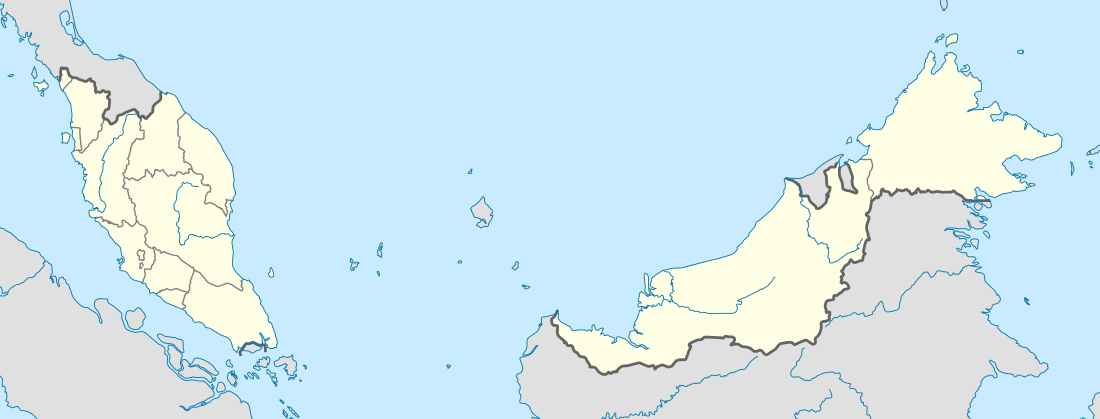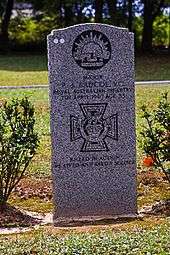Terendak Camp
Terendak Camp is a military camp of the Malaysian Armed Forces, is situated on the coast of the Malacca Straits about 14 miles (23 km) to the north of the state capital of Malacca.
| Terendak Camp | |
|---|---|
| Melaka, Malaysia | |
.jpg) Military aerial photography of the base taken some time in 1963. | |
 Terendak Camp | |
| Coordinates | 2.287213°N 102.09728°E |
| Type | Army Camp |
| Site information | |
| Owner | Malaysian Armed Forces |
| Controlled by | |
| Site history | |
| In use | 1959–present |
History
.jpg)
The camp was built to house the 28th Commonwealth Infantry Brigade Group on their move from North Malaysia in 1959 - 1960. Construction was started in 1957 and funded by Governments of Great Britain, Australia and New Zealand on a percentage basis.
Construction of Terendak was started in June 1957 and was completed by 1964. Terendak covered an area of close to 1,500 acres with an additional training area of 3,500 acres.
28th Commonwealth Infantry Brigade occupancy started in late 1959 and by the mid-1960s the camp was fully occupied.
The Garrison consisted of:[1]
- A Military Hospital
- A Transport Unit
- A Supply Depot (Foodstuffs, Fuel, Oil and Lubricants)
- A Education Centre
- A Civil Labour Unit
- A Hygiene and Malaria Control Unit
- Army Depot Police Detachment
- Barracks Services
- Commonwealth Brigade Units were accommodated in the following barrack areas:
- Brigade Headquarters - Martang-San Lines
- British Infantry Battalion - Imjin Lines
- Australian Infantry Battalion - Canberra Lines
- New Zealand Infantry Battalion - Wellington Lines
- Artillery Regiment - Solma-Ri Lines
- Field Engineer Squadron - Kohima Lines
- Ordnance and Workshops - Arakan Lines
- Field Ambulance and Hospital - Mandalay Lines
By the end of 1970, 28th Commonwealth Infantry Brigade vacated Terandak when it was handed over to the Malaysian army, and remains occupied by a Malaysian Infantry Brigade.
Facilities

Within Terendak Camp the following facilities were available:[2]
- Four churches, including
- St John's Protestant
- Corpus Christi Roman Catholic
- Four swimming pools
- 900 married quarters
- Clubs and messes
- Shopping arcades
- Schools and kindergartens, including:
- Slim High School
- Mountbatten Primary School
Terendak Garrison Cemetery
| Terendak Garrison Cemetery | |
|---|---|
| Commonwealth War Graves Commission | |
| Used for those deceased 1948-1975 | |
| Established | 1960 |
| Location | near |
| Burials by nation | |
Specific figures are not available | |
| Statistics source: Commonwealth War Graves Commission | |

28th Commonwealth Infantry Brigade were actively engaged in the confrontation with Indonesia from 1963 until 1966. Some casualties from this campaign are buried in the Terendak Garrison Cemetery, additionally some Australian and New Zealand casualties from the Vietnam war are also interred at Terendak. Dependents who died of natural causes and the remains of personnel from earlier conflicts are also interned in the Terandak Garrison Cemetery.
There are now 323 non-World War servicemen and dependent burials in the Terendak Garrison Cemetery.[3]
Repatriation of Australian war dead
On 2 June 2016, the remains of 32 persons interred at Terendak including several family members, plus one Vietnam War soldier interred at Kranji War Cemetery in Singapore, were repatriated to Australia, landing at RAAF Base Richmond on two Royal Australian Air Force C-17s. They had been dis-interred following agreement between the governments.[4]
Repatriation of New Zealanders interred at Terendak
Between 1960 and August 2018, 18 New Zealanders who had died in Malaysia or South Vietnam were interred in the Terendak Garrison Cemetery.[5] As the Terendak Garrison Cemetery is not a recognised Commonwealth Cemetery and the care and future of the New Zealand Graves could not be guaranteed, there was a wish by New Zealand veterans groups and some families to have the remains repatriated to New Zealand for reburial.[6] After considerable consultation and much resistance from the New Zealand Government, in 2017 an offer was finally made to the families of service personnel interred at Terendak to repatriate them at public expense as part of Project Te Auraki (The Return). Project Te Auraki is a New Zealand Government initiative to repatriate the 34 New Zealand service personnel interred in non Commonwealth War Grave Commission administrated cemeteries around the world. On 21 August 2018, the 18 New Zealand Servicemen interred at Terendak were repatriated to New Zealand, along with the 9 other Service personnel including one child interred in various cemeteries in Malaysia and Singapore.[7]
References
- B), Eaton, H. B. (Hamish (1993). Something extra : 28 Commonwealth Brigade, 1951 to 1974. Edinburgh: Pentland. ISBN 1858210496. OCLC 29468672.
- "Terendak Camp". marsden.me.uk. Retrieved 5 September 2016.
- "TERENDAK MILITARY CEMETERY, MALACCA". CWGC. Retrieved 2 September 2016.
- Remains of Australians buried in overseas military cemeteries arrive in Sydney, ABC News Online, 2 June 2016
- "Terendak Military Cemetery, Malacca". NZ War graves project. Retrieved 2 September 2016.
- van Beynen, Jack (23 May 2015). "Bringing home the forgotten fallen". Stuff.co.nz. Retrieved 21 February 2018.
- "Repatriation of the Remains of Military Personnel and Dependants 1955 - 1971". New Zealand Defence Force. 19 June 2018. Retrieved 29 June 2018.
| Wikimedia Commons has media related to Terendak Camp. |